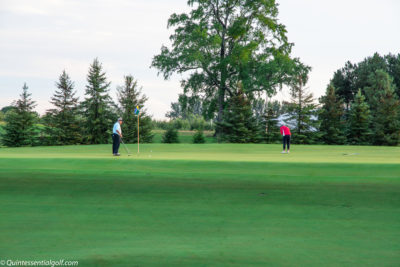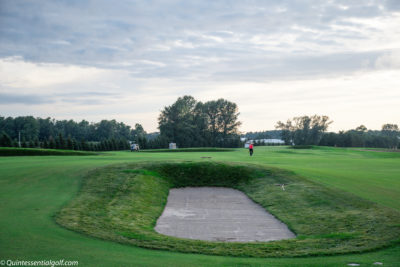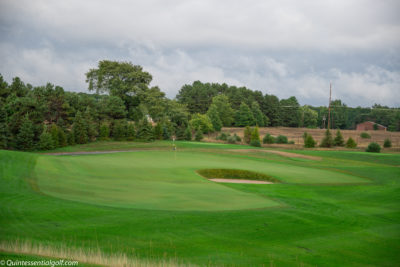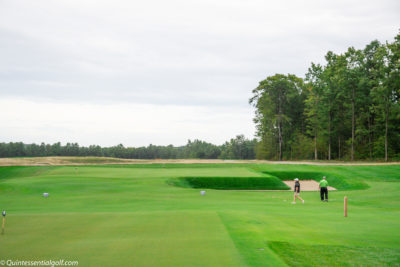The South Course at Arcadia Bluffs launched in 2018 with much adulation. It’s only a mile south of the main Arcadia Bluffs resort on the eastern shores of Lake Michigan. The original Bluffs course is acclaimed for its stunning panoramic views of Lake Michigan and tremendous sand dunes links style course. Golf Magazine ranks it #2 in Michigan and #36 in the country among public golf courses. The South Course is not yet ranked, but undoubtably will vault into the top echelon of Michigan golf. All players are Arcadia Resort guests. Hence, they can use all the facilities of the main resort including the fine dining, boutique lodge and practice range. The practice range at the South Course is even better than the Bluffs course.
The South Course History
Not content to rest on the laurels of the nationally acclaimed Bluffs course, the folks at Arcadia Bluffs set out to create an equally impressive but different golf experience than their first course. Looking to capture the emotions experienced at prominent private courses in the early days, they studied, then captured the design intricacies and principals of architects C. B. Macdonald and Seth Raynor. Macdonald is defined by founding and designing the Chicago Golf Club in 1893, the first 18-hole course in the U.S. and one of the most exclusive private clubs. The course mimics the features of Scottish Links that he learned while studying overseas.
C. B. Macdonald is known as the “Father of American Golf Course Architecture” and coined the term “golf course architect”. He defined twenty-one design features that form the basis of modern links design. It was his student, Seth Raynor, that commercialized MacDonald’s template designs throughout the country as demand intensified in the roaring times of the early 1900s.
Eleven templates are most used in links design.
- The Road Hole,
- The Redan Hole
- The Short Hole,
- The Alps
- The Double Plateau
- The Eden
- The Biarritz,
- The Punchbowl
- The Leven
- The Great Hazard
- The Cape Hole
They use variations of these templates in the South Course, but the goal was not to copy any exact template.
The South Course
Arcadia Bluffs Resort owner Rich Postma commissioned architects Dana Fry and Jason Straka to build a second course inspired by his favorite course, the Chicago Golf Club. They did not directly copy any holes but several are close templates.
Few Macdonald courses are public access as the vast majority are private courses. The Old White Course at the Greenbrier is a classic that allows public access. The South Course provides the public golfer the pleasure of experiencing many of these design concepts (templates) particularly on the front nine. golfer
The land is mildly undulating and designed to be walkable. It was logged many years earlier. Hence, there are only two trees on the course making wind a consistent factor. The routing reflects this as you change direction virtually every hole. Ten holes run east/west and eight holes run north/south so the prevailing wind of the day will be a factor in all directions. They situate teeing areas to avoid long forced carries in erratic wind conditions.
Key Features
Arcadia Bluffs promotes five features of the South Course that illustrate the architecture:
- Rectangular tees with 90-degree corners.
- Large greens averaging over 9400 square feet that often have 90-degree corners. Swales, ridges and slopes define different sections.
- A bold bunkering style defined by strong grass faces and ribbons of flat sand.
- Wide fairways and approaches offering optional lines of play.
- Firm and fast conditioning promoting the ground game around greens.
It’s about geometric angles. Rectangles and squares define the golf course features. It provides multiple angles for shotmaking. These features make the course pop out of the otherwise unremarkable rectangular section of flattish land.
Fairways are generous averaging 50-55 yards wide. Another 15-20 yards of clean cut rough. So there is a lot of cut grass to hit. But fairway bunkers are a dominant feature. Most of the fairway bunkers are rectangular, crossing the fairway and staggered with 2-4 foot grass faces. This reduces the size of the landing area putting a strong emphasis on accuracy. Your tee shot needs to find the best line and distance to avoid the bunkers. Virtually every par4 or par5 tee shot provides a choice to challenge the bunkers or play safe. Knowing how far these bunkers are and the distance you hit your woods is critical to success. Drives short of these bunkers may cause a long second shot. Mounding on the leading edge of these rectangular bunkers is common and used to penalize the recovery shot.
Player feedback is awe and astonishment at the rectangular traverse bunkers penetrating the wide well manicured fairways and protecting square greens.
The large tract of land used has sandy soil that drains well enables superb conditioning. Hats off to the Superintendent and the head of Agronomy. Its perfect – firm and fast. The excellent conditioning facilitates running the ball up to the greens. But when combined with common false fronts and mounded greens, the ball will also run off the greens just as easily.
The square greens are just a fantastic element that adds to the mystique. How close to the corners will they put the hole locations? The variety of hole locations and wind directions change the nature of the course from day-to-day. Playing Arcadia Bluffs South Course doesn’t get old, in fact, it takes multiple rounds to find your way to a comfort zone.
Hole Highlights
There are so many memorable and interesting holes.
Number six stands out. They position a large rectangular green so the four sides of the green are at 45-degree angles to the approach shot. They raise the green up to a plateau and a deep bunker surrounds the front and back left sides. The putting surface is the lightning fast and treacherous.
Seth Raynor introduced the Lions Mouth green complex, nowhere better illustrated than at the twelfth. A horseshoe shaped green surrounds a lone bunker in front on this downhill 175 yard par3. The resort calls it the boomerang green.
A punchbowl green is a large bowl that funnels shots towards the center. The greenside areas do not “run-off”, they “run-on” the green. They are fantastic for par 5s and long par 4s making it easier to find the putting surface. The long 414 yard par4 thirteenth incorporates a modest punchbowl that eases slightly offline shots toward the green. But more errant approach shots are gobbled up by thick rough, a distinct possibility since the approach shot is blind from the right side of the fairway.
A Redan is a long par3 with a green that runs diagonally sloping right to left protected by a long bunker on the left side and a small bunker long. The 238 yard par3 sixteenth is a modified redan. They replace the left bunker with a sloping grass area. They add two bunkers short right and long right. But they slope the front right to allow a run up onto the green.
The 384 yard par4 seventeenth is striking from the tee. Look toward a bank of three church pew bunkers covering the left half of the fairway. Then see a single rectangular bunker further twenty yards further covers the right side challenging the power hitter.
Summary
Given the variety of hole locations and the openness to variable winds it will take repeat play to learn the lay of the land. The South Course is a tribute to a bygone era. The focus on angles drives a strategic thinking for shotmaking. For everyday golfers, it provokes a wide range of reactions. You will hate it or you will love it. In either case, you will remember it. A perfect compliment to the main Bluffs course, don’t miss it when you go to Arcadia Bluffs resort.
Explore other Midwest golf course profiles from Quintessential Golf Magazine














